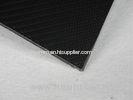

Black Twill Matte Carbon Fiber Panels use for surfboard / boat centerboard
| Place of Origin: | Guangdong |
|---|
Company Profile
| Location: | Shanghai, China (Mainland) |
|---|---|
| Business Type: | Manufacturer |
| Main Products: | Carbon Fiber Tube |
Product Detail
| Model No.: | AIA-1 |
|---|
Product Description
Twill Matte Carbon Fiber Plate 250mm * 350mm with material and standarstock.
Introduction
This carbon fiber plate unidirectional plate is layered up so that all carbon fibers run in 0° direction
(parallel to the long direction) of the part. It is used to add stiffness to almost any material: fiberglass,
foam, balsa wood, etc. The plate can be used for a variety of applications such as aircraft and rocket
fuselages, surfboards, boat centerboards, guitar necks, etc.
Information
Carbon filaments are often made from the oxidation and thermal pyrolysis of polyacrylonitrile material.
Polyacrylonitrile is a acrylonitrile-based polymer used in the creation of some synthetic materials.
Polyacrylonitrile molecules are made of long chains which are aligned by drawing continuous filaments.
When these chains are heated under the correct conditions they bond side to side forming ladder
polymers. Narrow graphene sheets are formed which merge together to make a single round filament.
This product is approximately 94-95% carbon. Instead of polyacrylonitrile, pitch or rayon can also be
used although this produces a lower-quality fiber. If the carbon is heat treated in the range of 1500-3000 degrees celcius, the fiber can become
a higher strength, higher molulus product.
The highest tensile strength (>800,000 psi) can be created by heating the fiber between 1500 and 2000
degrees. The highest modulus of elasticity (77,000,000 psi) can be obtained by heating the fiber material
from 2500 degrees to 3000 degrees. This balance between strength and elasticity is what allows a carbon
fiber hood to be so strong but also so durable. Carbon fiber density is about 1740 kg/m3. The three kinds
of carbon fiber are standard modulus, intermediate modulus and high modulus. Tensile strength tends to
vary between 2000 MPa and 7000 MPa. Rayon used to be a more popular precursor for carbon fibers
and is still used on some applications like rockets. However, it is not much more common for PAN or even
pitch to be used. The fiber yarns can be processed in many ways.
Advantage
1. High strength light weight
2. Low coefficient of thermal expansion
3. Resistance to corrosion
4. Durable nice surface ect.
Specification
|
Length mm |
Weave |
Finish |
Material Type |
|
250*350 |
Twill |
matte |
Full Carbon Fiber |


